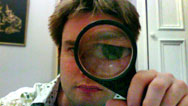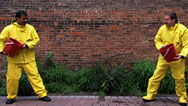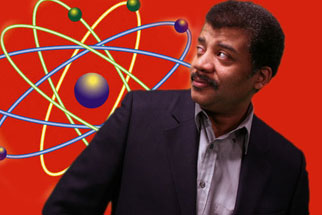Picturing Atoms
- By Susan K. Lewis
- Posted 06.01.08
- NOVA scienceNOW
The morning after physicist Ernest Rutherford discovered that atoms were mostly empty space, he was afraid to get out of bed for fear he'd fall through the floorboards. He got over it, says Neil deGrasse Tyson in this audio piece—as has Neil with his beef over how we typically ignore all that space when we depict atoms.
Transcript
Picturing Atoms
Posted: June 1, 2008
Part 1: A freaked-out famous physicist
NEIL deGRASSE TYSON: One of my favorite characters in the history of atoms is Ernest Rutherford, a physicist in the early 20th century. He was the first person ever to discover how empty atoms actually are. He had this clever experiment where he had this wall of atoms, a thin film of gold, and fired particles through that thin film of gold. Particles small enough to sort of maneuver their way through atoms, and it turned out most of his particles penetrated this thin film of gold and came out the other side untouched, unhindered, un-redirected, didn't collide with anything. And he realized, based on how many particles he shot through this field of atoms and how many came out the other side untouched, he concluded that atoms are mostly empty space. Mostly empty space.
He alone knew this about atoms and the structure of matter, and he was so freaked by this that the next morning he woke up, was ready to step out of his bed and was afraid to touch his foot to the floor out of fear that he would fall through the empty space of the atoms that comprised the wood of the wooden planks beneath his feet. Rutherford finally got over it and was able to get out of his bed and eat breakfast, but it's a fascinating state of mind when you've made a major discovery about the structure of matter, and no one else yet knows it.
Part 2: What's wrong with this picture?
NEIL deGRASSE TYSON: Well I love me some atoms, but I'm always frustrated because every time people try to draw atoms, they'll show the nucleus crammed with some particles, and then they show these electron orbits like it's some kind of mini solar system. Now, of course, that's what people used to think, 100 years ago, but really, the electrons are not orbits. They're just not. They move around so quickly, and they're like wave functions basically, described mathematically as a wave, that you can't draw an electron moving in any particular way. What you really should be showing is the cloud – the probability cloud – of where you might find the electron if you looked.
They're called orbitals, but nothing orbits. We're just stuck with a vocabulary that pre-dated the discovery of atoms. It came to us from the solar system. So, I'm okay with that, but don't then take the word that we've borrowed from the solar system and then treat it literally as it applies to atoms. Atoms are completely different beasts.
Then you show the nucleus all sort of tightly packed. That's pretty good. Pretty good. But the nucleus vibrates. It jiggles. Everything has sort of this jiggle property to it. Everything is in motion, even down to the nucleus itself.
So now, you've got the nucleus, and there's this huge, huge empty space between the nucleus and the electron orbitals. And so here's the problem. If you want to do it accurately, then you have to show this huge space—Huge! Huge! The size of the atom compared to the size of the nucleus is like a factor of a thousand larger. So, a picture of an atom would not be very interesting to look at, if drawn to scale. But as an educator, what you have to do is fake it a little, and shrink everything down, in scale, so that you can see the nucleus and the electron orbits together in the same view.
And I'm okay with that, because the goal here is to get the idea across that there is empty space – even if you don't show all of it, that there is this thing called electron orbitals – even if they're not actual orbits, and there is such a thing as a nucleus. And so once you get that point across, once you get to understand the basic structure of the atom, then you can give the rest of the story and then tell people, "Hey folks, this gap between the nucleus and the electrons, we faked it a little here just to stick it on the same page, but really it is huge."
And now the person learning about the atom has a foundation on which to stand to then learn the further details that you omitted in the first place. And that's called a pedagogical lie, and I'm okay with that, because it's a small lie to get you to a much bigger truth.
Credits
Audio Credits
- Produced by
- Susan K. Lewis and David Levin
- Interview by
- Susan K. Lewis
Image composite
- (Neil deGrasse Tyson)
- Photos by Chris Cassidy © WGBH Educational Foundation
- (atom on green background)
- © Images.com/Corbis, Bek Shakirov
- (atom on red background)
- © Digital Art/Corbis
Related Links
-

Dark Matter
Physicists have a sneaking suspicion that most of the universe is held together by a mysterious, invisible substance.
-

Dark Matter: Expert Q&A
Astronomer Richard Massey answers questions about dark matter and other otherworldly enigmas.
-

The Dark Matter Mystery
See how a cosmic collision provides evidence that dark matter really exists.
-

The Elegant Universe: Pt 1
Einstein's Dream: Combining the laws of the universe in one theory that explains it all is the Holy Grail of physics.
You need the Flash Player plug-in to view this content.




